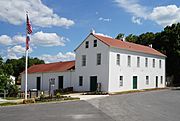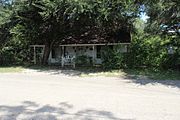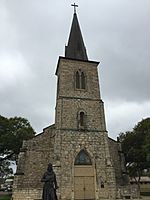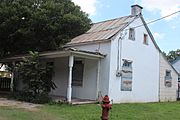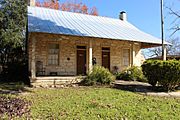Castroville Historic District facts for kids
Quick facts for kids |
|
|
Castroville Historic District
|
|

The original 1879 Medina County Courthouse (now Castroville City Hall), a historic structure within the district
|
|
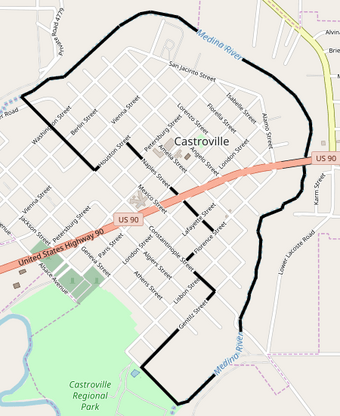
Map of the Castroville Historic District
|
|
| Location | Roughly bounded by the Medina River, SR 471, and Gime, Constantinople and Naples Streets in Castroville, Texas |
|---|---|
| Area | 420.6 acres (170.2 ha) |
| Architectural style | Colonial Alsatian, Victorian |
| NRHP reference No. | 70000758 |
| Added to NRHP | April 3, 1970 |
The Castroville Historic District is a special area in Castroville, Texas. It's like a time capsule showing the oldest parts of the city. This district has many important buildings. These include a Texas State Historic Site. It also has many Recorded Texas Historic Landmarks. This historic district was added to the National Register of Historic Places in 1970.
Contents
Discovering Castroville's Past
Castroville was started in 1844 by Henri Castro. He was an empresario, which means he was given land by the Republic of Texas. His job was to bring people to settle on this land. Henri Castro brought many families from Europe. They came from the Upper Rhine valley. This area includes Alsace and Baden. They settled along the Medina River, about 25 miles (40 km) west of San Antonio.
Why is Castroville So Special?
For a long time, Castroville kept its strong Alsatian feel. People spoke the Alsatian language even into the mid-1900s. The buildings also show Alsatian architecture. This unique style can still be seen today.
The oldest part of Castroville is surrounded by the Medina River on three sides. This area became a historic district on April 3, 1970. It was added to the National Register of Historic Places. This was because of its well-preserved Alsatian buildings. It also has a very unusual cultural heritage. Because of this, Castroville is known as the "little Alsace" of Texas. Castroville's district was one of the first three historic districts in Texas.
What Buildings Are Important Here?
When the district was named, twelve buildings were chosen as "contributing properties." This means they help make the district special. One of these is the Landmark Inn State Historic Site. This site is also listed on the National Register of Historic Places by itself. Other important buildings include St. Louis Catholic Church. Many private homes also show the unique building style. The district has many Recorded Texas Historic Landmarks. Many of these are old homes of the first settlers. They are very well-preserved.
Castroville's Unique Building Style
The buildings in the historic district were built between 1844 and the 1880s. They share common features that show their Alsatian style. The oldest houses usually have two rooms and a loft upstairs. Their walls are thick and made of limestone. They are covered with stucco. The beams inside are made of cypress or cedar wood. The roofs are sloped and gabled. They are covered with tin or cypress wood shingles.
How Were the Kitchens Built?
Often, the kitchen was attached to the back of the house. It might be a small shed-like room. Sometimes, the kitchen was a separate building nearby. The houses are usually built close to the front of their property. Many of them have wide front porches.
Historic Properties to See
- Historic properties within Castroville Historic District
-
Landmark Inn State Historic Site (about 1844); a very old and important place.


